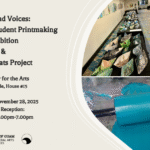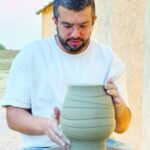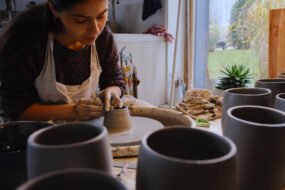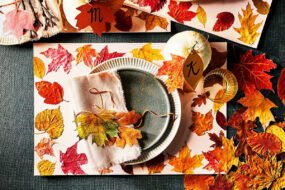
Arts and crafts do not always get along. Many craftspeople would rather look to history for inspiration than engage with contemporary art practice; some visual artists do not master traditional skills. Pamela Wilson, whose ceramics, paintings and tapestries are on view at Frog Hollow Vermont Craft Gallery in Burlington through August 29, navigates both worlds adeptly. Her exhibition, “Unveiling Transformation,” showcases both technique and highly conceptual thinking.
Wilson has created a suite of bottles, lidded jars, cups and other stoneware vessels that look as earthy as they actually are. Throughout this body of work, she has used “landscape-embedded” materials, such as shale, ash, granite and indigo, resulting in deep blues, brick reds and sandy speckles. The colors show off the ridges left by the potter’s wheel and drip or fade into each other. Many of Wilson’s ingredients are locally sourced, including the Barre granite, high in silica, which gives some of her vessels a glassy, almost iridescent sheen.
The collection’s colors, textures and proportions seem timeless, as though unearthed from an archaeological dig — except for the occasional inclusion of precise black spots, rectangles and stripes. Those add a distinctly modern twist to the work, their geometric precision complementing the vessels’ natural aesthetic.
The sense of time conveyed in Wilson’s ceramics, and that enters into her art practice more broadly, is one of her central preoccupations. “These sort of dialectics,” she said in a studio visit, “of discordant timelines and interdependent processes, that’s where the work is super satisfying.”
Wilson is a bit of a mad scientist when it comes to materials and processes. “If somebody tells me something is the hardest material to work with,” she said, “I’m going to run at it headfirst.” She has grown her own flax and indigo, spun her own yarn, made dyes from locally grown walnuts, and sourced her own granite dust from stone carvers in Barre, where she lives and works.
She’ll spend an afternoon at Studio Place Arts, boiling pigments into a dye bath for the yarn she weaves into her tapestries, throwing pots while the studio is humid from the infusing process. When her dye baths are spent and her ceramics need to dry, she uses the liquid to make paintings on Yupo, a nonabsorbent polypropylene paper. The water evaporates, creating abstract forms that look like shorelines and puddles.
Wilson creates her tapestries based on the imagery in the paintings. The result is two similar objects: one a record of the relatively fast passage of time, and one that has taken months to complete.
Wilson has been making things since she was a kid growing up near Peters Valley School of Craft in New Jersey. She didn’t attend the school but benefited from being in a craft-centered community. Historical reenactment was popular in the area; the first job she was offered out of high school was throwing pots for tourists at the “olde” pottery shop. Today, she’s interested in experiential archaeology, which tries to imagine how and why people made things the way they did by re-creating those processes. She has worked with the Vermont Weavers Guild and with Harlan Morehouse, a geography lecturer at the University of Vermont, on fiber and weaving research.
More broadly, Wilson sees networks of people who share information and technique as being central to any craft process. This is especially true of wood-firings, when ceramic artists bring their work to an outdoor kiln; the pieces in “Unveiling Transformation” are all wood-fired. These events are often multigenerational affairs in which people take shifts to fire the pottery for days at a time, sometimes while playing music or watching kids. Whoever is there becomes part of the team.
“You’ve got to figure out how to communicate quickly,” Wilson said, “and how to get to know each other really quickly, and how to understand your scope and what you can and can’t do.”
The skills she has learned in that context have served Wilson well in the past year. When the July 2023 flood hit Barre, she became integral in the recovery effort. Wilson is well connected within the arts community, from sculptors who supply her with pigments to fellow weavers to other artists at Studio Place Arts. People started asking her if she knew of anyone providing services and connecting volunteers with needs — things that weren’t happening because normal channels were overwhelmed.
Wilson began to meet daily with an unlikely combination of faith leaders, folks from the Rainbow Bridge Community Center, the city’s rec director and other volunteers who started organizing on the library’s front lawn. They strategized responses to needs such as trash pickup and distributing supplies on the fly. Weeks later, the group formed the long-term recovery organization Barre Up!
“It’s not that I was an obvious person, or that anyone who wound up being the group that was Barre Up! were the obvious people,” Wilson said. “We were the people who were there, and we said, ‘We’re going to figure it out together.'”
Wilson is still doing flood recovery work and thinks about it within the context of art making. “The actual real ridiculous conceptual question is: Is moving sandbags from one side of town to the other an arts practice? I will honestly say, I don’t know,” she said. “But it is complex systems thinking.”
That kind of thinking is what in master-of-fine-arts circles is called “social practice”: an art form related to performance art which relies on and strengthens human connections. (Think Rirkrit Tiravanija’s 1990s installations, such as “pad thai,” in which he cooked and served food to gallery visitors.)
What’s so different about Wilson’s version of social practice is that it’s based in craft tradition rather than art theory. To make a pot, she needs community as much as she needs clay. To strengthen community ties, she needs to do the physical work of flood recovery. It’s a circular process, a give-and-take. “It feels connected to this big, long history of humans doing things,” she said. “It keeps you really grounded.”















